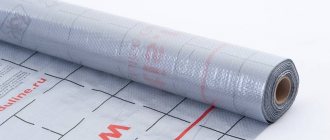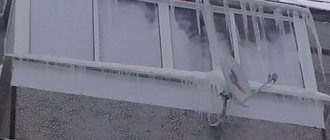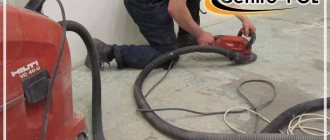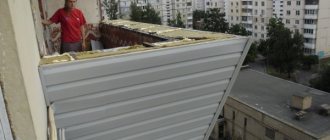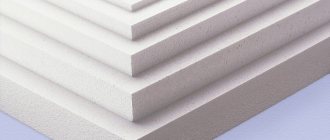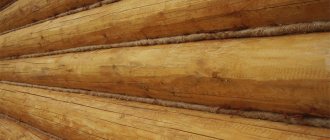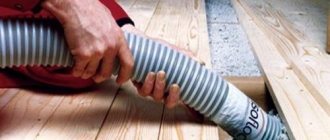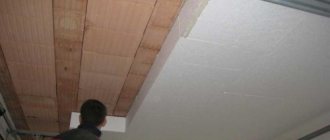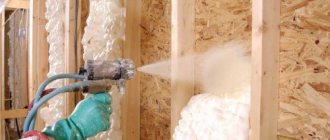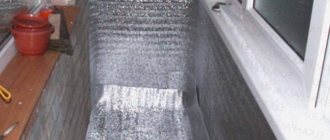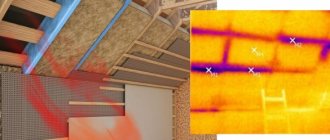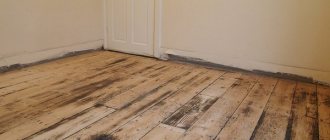Insulating a balcony is not an essential task; many, even after glazing a balcony or loggia, do not consider it important to provide additional insulation of the room.
Refusal of insulation is a wrong decision; glazing a balcony can provide some wind protection, noise insulation, and limited thermal insulation, but the balcony will not receive adequate thermal characteristics. In fact, refusal to insulate makes glazing pointless; the balcony, of course, will not be flooded by rain, but moisture, condensation and the direct temperature effect on the apartment will be reduced. The reason for refusing insulation may be both financial difficulties and reluctance to reduce the usable area of the balcony, however, at the moment there are many materials that are affordable, effective and thin enough to become a panacea when carrying out the process of insulating a balcony. The best modern budget insulation material is penofol.
What is penofol and what are its advantages and disadvantages?
Penofol is a multilayer insulation, the main component of which is polyethylene foam, covered on one or both sides with a layer of polished aluminum foil. Due to its characteristics, it can be used separately, without the use of auxiliary materials, but for a more effective result it can be combined with other insulation materials. Foamed, so-called self-extinguishing polyethylene, which is part of penofol, has a structure of closed air pores, which ensures maximum thermal insulation with minimal dimensions.
Interesting to know! Having a thickness of only a few millimeters, penofol does not take up much usable space in the room; it can replace 100 millimeters of mineral wool materials and is used to insulate walls, floors, ceilings, roofs, etc.
Available in rolls, ensuring rational use and ease of operation.
Insulating a balcony with penofol has a number of advantages compared to the use of other insulating materials. First of all, it is a high degree of insulation and protection from water and steam. Among the main advantages of penofol are characteristics such as reflection of up to 98% of thermal energy, lightness and flexibility, long service life, ease of installation, operating temperature in the range from −60 to +100 degrees, and affordable price.
The composition of penofol ensures not only heat retention during the cold season, but also a comfortable temperature during the summer heat, preventing overheating of the balcony. For use in hard-to-reach areas or rounded surfaces, a special self-adhesive penofol coated with adhesive and protective film is well suited, affordable temperature in the range of −60, reflection of up to 98% of heat energy, lightness and flexibility,
However, penofol has one drawback - it cannot be used under a screed, since the foil shrinks when interacting with cement and loses its useful properties.
The technology of insulating a loggia with penofol is somewhat different from insulating a balcony, due to the fact that it is a built-in room, but general stages in these activities can be identified.
Penofol - the newest generation of insulation
Penofol is one of the latest developments in the field of insulating materials. The main secret of its highest technical qualities lies in the successful combination of foamed polyethylene and aluminum foil. This material is able to provide comprehensive protection for the loggia:
- Thermal insulation. Due to the low thermal conductivity of polyethylene foam and the heat-reflecting properties of aluminum foil, heat loss in the room is sharply reduced. The material is capable of reflecting about 95–98% of thermal energy.
- Moisture insulation. The hydrophobic properties of penofol make it possible to use it to create a waterproofing contour. The material prevents rain moisture and atmospheric fumes from entering the room from outside.
- Noise insulation. Soft, porous polyethylene perfectly absorbs any external noise, which is especially important if the balcony faces a busy street.
Due to its complex protective properties, it can be used in isolation, without the use of additional materials. Thus, insulating a loggia with penofol does not require laying a preliminary layer of waterproofing.
Positive aspects of the material
The insulating layer of foamed polyethylene is only a few millimeters. However, in terms of its thermal insulating properties, it is equivalent to a 10 cm layer of mineral wool. Such high performance was achieved thanks to special technology. Molten polyethylene foams under high pressure, resulting in the formation of a special structure inside it - closed air bubbles that prevent heat transfer. The operating temperature range of the insulation is from -100 to +60 degrees.
Lightweight and flexible penofol is most convenient for insulation
Among other positive qualities of the material are:
- Small thickness. When covering a room with a limited volume, such as a balcony, the thickness of the heat-insulating material is an important factor.
- The lightness and flexibility of penofol make it as convenient as possible to use. It is quite possible to install insulation by one person without the involvement of finishing specialists.
- The strength of the material and its ability to withstand changes in temperature and humidity make penofol as durable as possible.
- The low price makes this material the best choice according to the “price – quality” criterion.
Preparatory activities
Preparatory work includes cleaning the walls, eliminating roughness, and filling gaps and cracks with polyurethane foam. At the preparatory stage, you should choose which materials the penofol will be laid with, and also determine the number of layers. Most often, insulating materials are installed in two layers; you can get by with one penofol or combine it with other materials, for walls with penoplex, for the floor with foam, and two layers of penofol are laid on the ceiling.
Primary waterproofing is carried out using a two-millimeter polyethylene film attached to the walls, ceiling and floor using liquid nails or bolts.
Main tasks of thermal insulation
The materials used to insulate a balcony from the inside can be very diverse. Mineral wool and solid insulation materials, such as polystyrene foam, penoplex, penofol and its other analogues, are also suitable. It is worth noting that working with solid insulation that does not separate into fibers is much more convenient. Installation is faster, additional insulation from the insulation itself is not required, it is easier to attach to the walls, it does not allow cold air to pass through, so a vapor barrier layer is not needed, which can significantly reduce the cost of work.
Option for insulating a loggia with penofol
You can insulate a balcony with penofol yourself. This process will not be difficult and will not require any special skills or tools. By glazing and insulating the loggia, you can turn it into a useful space that can be used at any time of the year, regardless of weather conditions. Such a hanging structure will not only preserve heat in the room, but also expand the space of the room by several square meters. They can be used as a relaxation room, an office, a library, or storage of various items that require certain temperature conditions and the absence of moisture.
Scheme for laying penofol insulation on a balcony
Insulating the balcony with penofol or similar materials will quickly and effortlessly insulate cold air, making the room comfortable. The costs of work and the purchase of material will be minimal.
Wall insulation
The most successful working environment for penofol is air, thanks to which the thermal insulation qualities of this material are fully ensured, therefore it is necessary to ensure the presence of an air gap of 1.5-2 cm on both sides of the penofol during its installation; for this, an internal lathing is created from wooden slats. Further insulation measures are carried out in several stages:
- Slabs are cut from a roll of penofol, taking into account the surfaces on which they will be laid, then the prepared sheets are attached to the sheathing using liquid nails or self-tapping screws, preventing the formation of joints at the corners of the balcony (it should be folded at the corners). It is important to remember that penofol with one-sided coating must be mounted with foil inside the room.
- The gaps between the plates are eliminated - an aluminum film or special tape is glued to the seams, you can also use regular polyurethane foam or silicone.
- Using slats 20 by 40 mm, installed parallel to the floor, a second layer of sheathing is mounted; the distance between the slats should be about 40 cm. As in the first case, the sheathing ensures an air gap of 2 cm between the insulation and the coating that follows it.
- The lathing is covered with finishing material, which can be chipboard and MDF profiles, lining, etc.
Features of installing penofol on different surfaces
The preparation of the base surface will be approximately the same in all cases. It needs to be leveled, all foreign elements removed, cracks and depressions filled with polyurethane foam, and excess foam cut off. The number of layers of insulation and the selection of the optimal combination of materials depends on what surface they are mounted on and what climate zone you live in. Most often, two layers of insulation are installed. In addition to penofol, penoplex is usually used for walls, polystyrene foam is used for floors, and both layers of penofol are used on the ceiling.
The maximum effect from using penofol on the balcony will be achieved if there is an air gap of approximately 2 cm on both sides of it. This can be easily achieved by installing a frame of thin bars.
Penofol insulation of all balcony surfaces
We insulate the walls
The first layer is polystyrene foam. The slabs are glued to the wall and secured with disc-shaped dowels. Each subsequent row is laid out offset to avoid vertical seams matching. If any section of the wall turns out to be smaller in area than the penoplex slab, the slab is cut before installation in accordance with the measurements. When the installation of this layer is completed, all joints are filled with foam. Next, work with penofol begins. The material is cut into pieces in accordance with measurements, laid and fixed with screws with a wide head.
We insulate the walls with penofol
Do not forget that penofol with one-sided coating should be placed with foil inside the room. The strips are mounted end-to-end, not overlapping, and foil tape is used to seal these joints.
Then you need to make a lathing to which the decorative coating will be attached; it will also create an air gap between the finishing material and the insulation. For the sheathing you will need slats (20 by 40 mm); they are installed parallel to the floor at a distance of approximately 45 cm from each other, checking their position using a level. Leave space between the first batten and the floor for the baseboard. The cladding material is mounted on the finished sheathing.
We insulate the floor
First, make and secure the timber sheathing, not forgetting that there should be a gap between the outer elements and the wall. Then foam is placed in the gaps. Try to ensure that the insulation fragments exactly match the space allocated for them; the fewer gaps there are, the better. All resulting gaps are filled with foam. As a result, you should have a flat surface; do not allow the insulation to protrude above the sheathing.
We insulate the floor with penofol
The next layer is penofol. To calculate the length, we proceed from the dimensions of the balcony, but add approximately another 40 cm for adjustment. When laying, it is useful to mark the location of the sheathing elements. Sheets of plywood will be placed on top of the insulation; they are fixed using self-tapping screws, which are screwed through penofol into the sheathing. There should be about a centimeter between the plywood and the walls. Excess insulation is trimmed off. Next, you can apply the decorative coating of your choice.
We insulate the ceiling
Penofol is fixed to the ceiling with slats, the first layer is transverse, the second is longitudinal. The type of fastener, as in previous cases, is self-tapping screws. The joints of the strips with each other and with the walls are foamed. The insulation of the second layer must be cut with a margin to create a joint with the one that was mounted on the wall. Usually three longitudinal slats are enough, one is placed in the middle, the other two are at an equal distance from it, but not close to the wall (a gap of at least 10 cm).
We insulate the ceiling with penofol
Do not immediately screw the slats tightly. They will serve as the basis for the final coating, so it is important to get them in the correct position. To do this, use a level; if necessary, you can place wooden wedges under the rail in some places, only after this the screws are screwed in completely. Plastic panels or some other lightweight material are suitable for cladding.
So, let's summarize. Penofol has many useful properties that make its use as an insulating material very effective. It is easy to install and takes up very little space, which is especially important when it comes to a small space. That is why insulating a balcony or loggia with penofol is considered very simple and extremely effective.
Floor insulation
Warming floors involves the following manipulations:
- A wooden frame is constructed from beams, which is attached to the floor surface with screws or bolts, while there should be a small gap between the outer beam and the wall. It is necessary to ensure a flat surface so that the penofol does not protrude above the sheathing.
- Penofol is laid in such a way that a dense, sealed surface is formed. The length of the insulation is taken from the calculation of the length of the balcony, with 40 cm added for adjustment.
- The outer layer of the sheathing is installed and covered with rough finishing material.
Types and properties of penofol
Penofol has high thermal insulation qualities and also helps create protection against evaporation and moisture. The material is polyethylene, foamed in a special way in a production plant, one side is covered with polished foil.
It is the foil that provides the material with good thermal insulation qualities. The form of release of penofol is sheets rolled into rolls. The material is quite flexible and lightweight; these characteristics provide additional convenience during installation. If necessary, such a heat insulator can be folded as desired, measured and cut into pieces of the required size. This allows you to use insulation more economically.
Such thermal insulation can be selected in different thicknesses, depending on specific conditions. Additionally, penofol also acts as good sound insulation, which in a noisy city is a rather valuable quality.
READ MORE: Methods of heating balconies and loggias
In building materials stores, penofol can be presented in various forms:
- The simplest type is designated as A - the polyethylene foam panel has only 1 foil side. During installation of the canvas, the foil layer is turned inside the room. The heat will thus be reflected from the foil layer and stored inside without escaping to the street.
- Penofol type B has a 2-sided coating. Such equipment helps to retain heat in the winter, and in the summer it prevents excessive heat by preventing the sun’s rays from entering the room.
- Type C, like type A, has a layer of foil on only one side. The other is coated with an adhesive composition, which is covered with a film on top for protection. This insulating material is convenient to use for thermal insulation of areas that are difficult to access. It is often used for thermal insulation of rounded surfaces.
- Varieties are also produced, marked as M and R. One of their sides is flat, the other has a relief. These types are intended for use in structures composed of several layers.
Within the named types of insulation there are also subtypes that differ in the thickness of the main layer of foamed polyethylene.
Ceiling insulation
The ceiling is not the warmest part of the balcony, so penofol should be laid in two layers, the first layer is mounted using transverse slats, and the second with longitudinal slats, usually three pieces are enough, all joints and cracks are sealed with polyurethane foam. The second layer of insulation should be laid end-to-end with penofol on the walls. External battens are used to attach trim and must form a flat surface.
At the stage of installing external sheathing and covering walls, ceilings and floors with finishing materials, the presence of electrical wiring, heated floors and sockets should be immediately provided.
To summarize, it should be said that if you have minimal knowledge and skills, insulating a balcony with penofol with your own hands will not be a huge task, because the installation of this material is simple and convenient.
Physical characteristics of penofol
Penofol is one of the latest developments from manufacturers of high-quality multi-tasking insulation materials. It is made of aluminum foil and polyethylene foam.
The main positive quality of this material is its high thermal insulation performance. Its additional positive characteristics include the possibility of using it for steam, sound and waterproofing, as well as for reflecting heat flows.
If penofol is laid in two layers, then the waterproofing of the room can be neglected. In addition, the characteristics of penofol make it possible to provide stable warmth in the room during the cold season and, conversely, keep it cool on hot days. Modern manufacturers produce this material in rolls, in which its thickness can vary from 3 to 10 mm, that is, during installation it has almost no effect on the free space.
We insulate the balcony with penofol with our own hands
Penofol has a structure that makes it easy to cut it into sheets of the required size and shape; it adapts perfectly to any repair conditions. The polyethylene foam included in its composition makes it possible to fasten this material with screws or nails, without reducing its thermal insulation characteristics.
Penofol with different properties is labeled with different letters. The marking in this case means the following:
- A: covered with foil, which ensures its vapor- and waterproofing properties, on one side (it is recommended to strengthen such sheets by placing them with foil against the wall adjacent to the street);
- B: The same coating is located on both sides, so it can be attached in any direction;
- C: on one side there is foil, and the other is self-adhesive (this material is used on walls for which the issues of vapor and waterproofing are less relevant, that is, on those adjacent to the interior);
- R: has a relief surface, and is covered with foil only on one side;
- M: has the same surface, but covered with foil on both sides:
- ALP: covered with polyethylene film with lamination on one side and covered with foil on the other.
Penofol contains a filler that has a structure with completely isolated pores and, due to the air enclosed in them, provides excellent thermal insulation with minimal dimensions. Polyethylene is covered on one (and sometimes on both) sides with aluminum foil no more than 14 microns thick.
Modern penofol can be classified as an average-cost heat insulator: its cost is significantly less than penoplex and mineral wool, but at the same time it is somewhat more expensive than polystyrene foam. Its thermal insulation characteristics are correspondingly lower than those of polystyrene foam, but higher than those of the cheaper materials mentioned above.
Thermal insulation on the top floor
If you have to insulate the ceiling on a loggia or balcony located on the top floor, you need to pay special attention to waterproofing. In this case, a layer of foiled polyethylene (penofol) must be laid under the penoplex slabs. It will not only additionally retain heat, but will also provide reliable protection from moisture. If you neglect this stage, then during rain the ceiling will begin to leak.
However, a layer of foil polyethylene can also be laid if the loggia or balcony is not on the top floor. Then it will additionally prevent the formation of condensation (that is, it will provide a vapor barrier) and prevent the formation of dampness and the proliferation of fungus. In short, it is advisable to lay a layer of waterproofing in any case.
After completing the installation of waterproofing and insulation, you can proceed to the finishing stage. The finishing can be done using a variety of materials: plastic or wooden lining, plasterboard, PVC panels, etc. Thanks to the variety of shades and textures, the finish can be matched to any interior style.
To summarize, it can be noted that insulating the ceiling on a balcony is not a complicated process, but attention to detail plays an important role. Namely, the correct choice of insulation, careful sealing of joints and cracks, installation of reliable sheathing, accurate marking, etc. This is what directly affects the service life of the heating and the effective performance of its functions in maintaining a comfortable temperature in the room.
How to attach penofol to surfaces made of different materials
If the loggia is insulated with penofol, you need to familiarize yourself with the nuances of the work in advance.
Be sure to consider the nature of the surface on which you are going to attach the rolled material.
First, the surface for work is thoroughly prepared. It will be approximately the same regardless of the material. The surface should be leveled as much as possible, protruding irregularities should be removed, and cavities and gaps should be filled with putty or polyurethane foam. The selection of materials depends on the nature of the surface being treated.
The number of layers of material and its thickness are selected based on the characteristics of the climatic zone. Penofol is usually used in 2 layers. Additionally, you can use penoplex to insulate the walls, and lay polystyrene foam on the floor. Attach double penofol to the ceiling to achieve maximum thermal insulation effect.
READ MORE: Insulation of a cold glazed balcony
Main technical characteristics
Having learned about the advantages and disadvantages, it is worth finding out what basic technical parameters this material has:
- It is used at the following temperature limits: from -60 to +100 degrees;
- Thermal reflection coefficient reaches: 97%;
- The value of the thermal conductivity coefficient ranges from 0.037 to 0.052 W/m*C;
- Vapor permeability parameters do not exceed: 0.001 mg/m*h*Pa;
- Specific heat capacity - 1.95 J/kg*C;
- Sound wave absorption: no less than 32 dB;
- The specific gravity of 4 mm penofol is 44-74 kg/m3.
